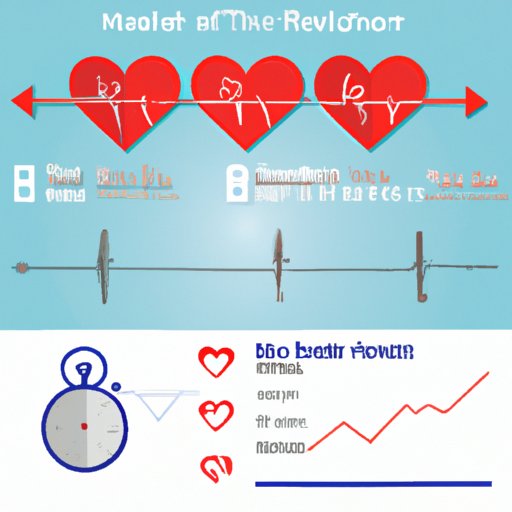
Introduction
Exercising has a lot of benefits for our body. However, it is also common knowledge that heart rate increases while doing strenuous physical activities. Why does that happen? In this article, we will explain the science behind why our heart rate increases during exercise and talk about why monitoring your heart rate during exercise can be beneficial.
The Science Behind Increased Heart Rate During Exercise: Understanding the Cardiovascular System
The cardiovascular system comprises the heart, blood vessels, and blood. The primary function of the cardiovascular system is to transport oxygen and other essential nutrients to the cells of the body. Another vital role of the cardiovascular system is to collect waste products from cells and remove them from the body.
The heart is responsible for pumping blood throughout the body. The amount of blood pumped per minute is called cardiac output. The cardiac output is determined by two factors – heart rate and stroke volume. Heart rate is the number of times the heart beats in one minute, while stroke volume is the amount of blood pumped with each contraction of the heart.
The body maintains its internal balance by regulating heart rate. The Medulla Oblongata, which is located in the brainstem, controls heart rate. The Medulla Oblongata receives information about the body’s oxygen requirements and sends signals to the heart. When we exercise, our oxygen requirements increase, and the Medulla Oblongata signals the heart to pump faster to meet the oxygen demand.
Unpacking the Benefits of Increased Heart Rate During Exercise: A Guide for Fitness Enthusiasts
Aerobic exercise is any activity that increases oxygen consumption by the muscles. Aerobic exercise helps to improve cardiovascular health, strengthen the heart muscle, and increase lung capacity. Some common aerobic exercises include running, cycling, swimming, and walking.
Aerobic exercise also helps to lower blood pressure, control blood sugar levels, and maintain a healthy weight. Additionally, aerobic exercises release endorphins, which are hormones that make us feel good, reduce stress and anxiety, and improve overall mental health.
If you are new to incorporating aerobic exercise into your fitness routine, start with low-intensity exercises such as walking or cycling and gradually increase the intensity and duration over time. The American Heart Association recommends at least 150 minutes a week of moderate-intensity or 75 minutes a week of vigorous-intensity aerobic activity for adults.
Why Your Heart Speeds Up During Exercise: Exploring the Connection between Physical Activity and Heart Health
The relationship between physical activity and heart health has been well-established. Physical inactivity is a risk factor for several chronic diseases, including heart disease, obesity, diabetes, and some forms of cancer. Regular aerobic exercise can help to reduce the risk of developing these diseases.
Heart disease is one of the leading causes of death worldwide. Risk factors for heart disease include high blood pressure, high cholesterol levels, smoking, obesity, and physical inactivity. The good news is that many of these risk factors can be modified or prevented altogether with lifestyle changes, including regular physical activity.
Exercise can help improve heart health by strengthening the heart muscle, improving circulation, reducing inflammation, and increasing oxygen delivery to the body’s tissues.
Pumping Up Your Heart Rate: How Exercise Affects Your Body’s Cardiovascular Response
When we exercise, there is an increased demand for blood flow to the muscles. To meet this demand, the blood vessels in the muscles dilate, increasing blood flow to the area. At the same time, the heart pumps faster, increasing the amount of oxygen-rich blood the muscles receive.
The sympathetic nervous system regulates the heart rate during exercise. The sympathetic nervous system is part of the autonomic nervous system, which is responsible for involuntary functions, such as heart rate and breathing rate. During exercise, the sympathetic nervous system is activated, causing an increase in heart rate and respiratory rate.
VO2 max is a measure of an individual’s aerobic capacity or their body’s ability to use oxygen during exercise. Regular exercise can increase VO2 max, indicating improved cardiovascular fitness.
The Importance of Monitoring Your Heart Rate During Exercise: Tips for Maximizing Your Workout and Staying Safe
Monitoring your heart rate during exercise is essential to ensure that you are exercising at a safe level and getting the most benefits from your workout. The target heart rate zone is the range of heartbeats per minute that you should aim for during exercise. The target heart rate zone varies by age and fitness level, and it is recommended to consult a physician/advisor before starting any exercise routine.
There are many ways to monitor heart rate during exercise. One common method is to use a heart rate monitor, which can track heart rate throughout the workout. Another way is to stop during exercise and check your pulse rate manually.
Exercising with a high heart rate can be dangerous and increase the risk of cardiovascular complications. It is crucial to avoid over-exerting yourself and to gradually increase the intensity and duration of the workout over time.
Conclusion
In conclusion, heart rate increases during exercise to meet the body’s increased oxygen demand. Regular aerobic exercise can improve cardiovascular health, lower the risk of chronic diseases, and improve the overall quality of life. As with any physical activity, it is essential to monitor your heart rate and find a safe level of activity that meets your fitness goals. Combine healthy eating habits with regular exercise to optimize your results and enjoy a healthy, active lifestyle.




